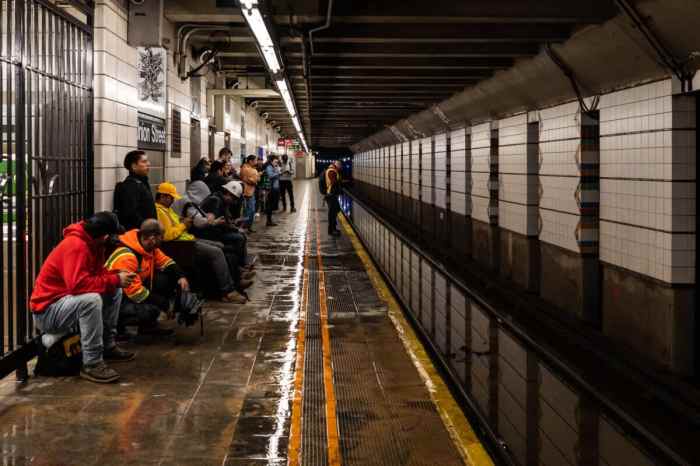Alarmed U.S. advocates, elected officials decry lack of emphasis
America’s secretary of health and human services, Tommy G. Thompson, commemorated the 16th annual World AIDS Day on December 1 with a statement from his office overlooking the Capitol in Washington, saying that the United States and the Bush administration are making “unprecedented commitments” to fight the AIDS epidemic and remain “unwavering” in their efforts to stop it. But AIDS advocates and the heads of social service agencies across the country are calling the AIDS funding in this year’s federal budget, now headed for the president’s desk, inadequate and even, said Fred Dillon, of San Francisco’s AIDS Foundation, “frightening.”
According to Thompson, the budget provides $2.4 billion for international AIDS programs, but at home the $2 billion Ryan White CARE program will be essentially flat-funded, and the federal AIDS Drug Assistance Program, or ADAP, got a little more than one-tenth of the money advocates say it needs to continue to provide low-cost AIDS medications to those not able to afford them. Advocates like Dillon say that this program is the single most essential life-saving measure in the government’s panoply of AIDS programs, but because AIDS patients are living longer and the number of patients relying on the program is growing, they say a $200 million increase will be needed to provide the same level of services it is now. This year’s budget provides just $25 million more.
So increasingly the cost of AIDS programs, like ADAP, are falling back on states and municipal governments which themselves are seeing shrinking tax revenues. In California last year, after protracted lobbying by gay Democratic state Assembly members, such as Santa Cruz’s John Laird and San Francisco’s Mark Leno, Republican Gov. Arnold Schwarzenegger included about $100 million from the state’s general fund to augment the approximately equal amount the federal government contributed last year. So, unlike some states that do not chip into their programs, California has no waiting list and Californians get most of the newest and most expensive drugs in the formulary. In New York the situation is similar, although threatened by proposed cuts in Albany.
But in other smaller states, where the AIDS epidemic mimics the situation California and New York saw ten years ago, federal dollars are even more important. “We don’t have enough money to serve all the people who need services,” said Jean Ann Van Krevelen who heads Oklahoma’s Regional AIDS Interfaith Network. She says that in Oklahoma AIDS patients are stigmatized. “It’s still very much a gay disease. We’re behind the infection curve, we’re behind the cultural curve – we got bagels like ten years ago,” she said, and that as a result local funding is slow to come.
In the U.S. overall, African-American women account for nearly two-thirds of the new HIV infections annually. “At Gay Men’s Health Crisis in New York,” said AIDS advocate and AIDS quilt founder Cleve Jones, “the majority of the people served there are neither gay nor men. It’s African- American and Latino women.”
As of September, eleven states had waiting lists for their ADAP programs. In North Carolina, the state with the longest list, over 500 people were waiting as long as eleven months to start getting AIDS medications.
In June, Pres. Bush authorized a one-time special appropriation of $20 million for 10 of those states, and just two weeks ago North Carolina eliminated its waiting list. But much of the money to do that came from a North Carolina General Assembly appropriation of $2.75 million. That, said the state’s AIDS policy director Stephen G. Sherman, brought the state’s contribution to over $11 million, more than a third of the state’s ADAP budget, “extraordinarily large in real money and in percentage terms,” Sherman said. But North Carolina requires that patients be extraordinarily poor to qualify for the program. Individuals must earn as little as $11,600 to qualify. A family of four can only earn $23,000. “And it’s an all or nothing situation,” he said.
While Sherman says he doesn’t know if anyone in his state has died as a direct result of not getting medications because of the state’s wait list, “I am certain there are people who were on the list who have died,” he said.
National lawmakers, like House minority leader Nancy Pelosi (D-San Francisco) have said that the president’s budgets fall far short of the needs of people living with HIV.
Other Democrats, like Rep. Barney Frank (D-Massachusetts), who is gay, say that the reason for the shortages in this year’s $388 billion budget is simple. “It’s an inevitable consequence of tax cuts and the war in Iraq,” Frank told Gay City News on Wednesday. He said the Democrats had “very little” influence over the appropriations process, and the cost of the war in Iraq, according to the Massachusetts-based National Priorities Project, is likely to reach as much as $152 billion by the end of 2004.
Frank says that Republicans postponed adoption of this year’s budget bill until after the November election. “They didn’t want people to know how bad it was going to be,” he said. But Frank rejected the notion that gays and lesbians should be a special interest constituency. “If they can get every group to care only about its own little piece, they win,” he said. “Why should the gay community care only about AIDS?” he asked. “That’s a selfish and unattractive view…What’s more important, people with AIDS or hungry children? I think it’s basically a moral matter.”

































